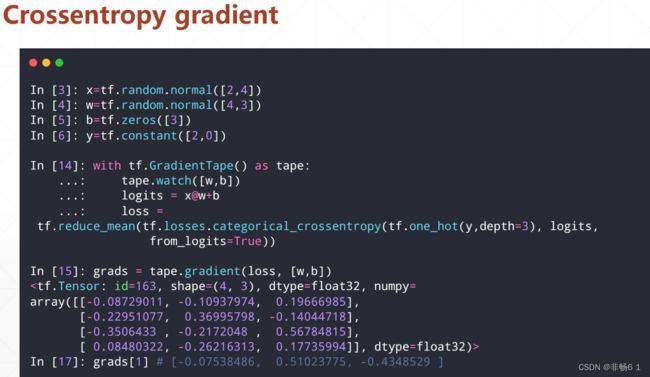tensorflow04
随机梯度下降
Gradient
激活函数及梯度
sigmoid
tanh
relu
损失函数及梯度
链式法则
函数优化
Himmelblau函数优化
手写数字问题
import tensorflow as tf
from tensorflow import keras
from tensorflow.keras import datasets, layers, optimizers, Sequential, metrics
import os
os.environ['TF_CPP_MIN_LOG_LEVEL'] = '2'
def preprocess(x, y):
x = tf.cast(x, dtype=tf.float32) / 255.
y = tf.cast(y, dtype=tf.int32)
return x,y
(x, y), (x_test, y_test) = datasets.fashion_mnist.load_data()
print(x.shape, y.shape)
batchsz = 128
db = tf.data.Dataset.from_tensor_slices((x,y))
db = db.map(preprocess).shuffle(10000).batch(batchsz)
db_test = tf.data.Dataset.from_tensor_slices((x_test,y_test))
db_test = db_test.map(preprocess).batch(batchsz)
db_iter = iter(db)
sample = next(db_iter)
print('batch:', sample[0].shape, sample[1].shape)
model = Sequential([
layers.Dense(256, activation=tf.nn.relu), # [b, 784] => [b, 256]
layers.Dense(128, activation=tf.nn.relu), # [b, 256] => [b, 128]
layers.Dense(64, activation=tf.nn.relu), # [b, 128] => [b, 64]
layers.Dense(32, activation=tf.nn.relu), # [b, 64] => [b, 32]
layers.Dense(10) # [b, 32] => [b, 10], 330 = 32*10 + 10
])
model.build(input_shape=[None, 28*28])
model.summary()
# w = w - lr*grad
optimizer = optimizers.Adam(lr=1e-3)
def main():
for epoch in range(30):
for step, (x,y) in enumerate(db):
# x: [b, 28, 28] => [b, 784]
# y: [b]
x = tf.reshape(x, [-1, 28*28])
with tf.GradientTape() as tape:
# [b, 784] => [b, 10]
logits = model(x)
y_onehot = tf.one_hot(y, depth=10)
# [b]
loss_mse = tf.reduce_mean(tf.losses.MSE(y_onehot, logits))
loss_ce = tf.losses.categorical_crossentropy(y_onehot, logits, from_logits=True)
loss_ce = tf.reduce_mean(loss_ce)
grads = tape.gradient(loss_ce, model.trainable_variables)
optimizer.apply_gradients(zip(grads, model.trainable_variables))
if step % 100 == 0:
print(epoch, step, 'loss:', float(loss_ce), float(loss_mse))
# test
total_correct = 0
total_num = 0
for x,y in db_test:
# x: [b, 28, 28] => [b, 784]
# y: [b]
x = tf.reshape(x, [-1, 28*28])
# [b, 10]
logits = model(x)
# logits => prob, [b, 10]
prob = tf.nn.softmax(logits, axis=1)
# [b, 10] => [b], int64
pred = tf.argmax(prob, axis=1)
pred = tf.cast(pred, dtype=tf.int32)
# pred:[b]
# y: [b]
# correct: [b], True: equal, False: not equal
correct = tf.equal(pred, y)
correct = tf.reduce_sum(tf.cast(correct, dtype=tf.int32))
total_correct += int(correct)
total_num += x.shape[0]
acc = total_correct / total_num
print(epoch, 'test acc:', acc)
if __name__ == '__main__':
main()TensorBoard可视化
visdom
Keras高层API

















